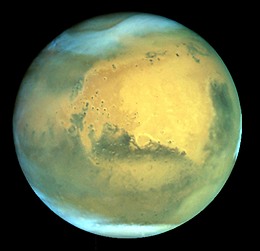The key sentence in the article is:
"Secondly, the scientists can now prove that water exists in its elementary structure. Further studies will be needed, but most researchers are now certain that what they are seeing really is frozen water."
More on this topic in my Mars section.
By Thomas Mueller
WASHINGTON (dpa) - The search for water on the planet Mars and with it, possible forms of life, is one of the main tasks of the NASA space probe "Mars Odyssey 2001".
And after its initial exploratory work, all the doubts have been removed, to the excitement of the scientific community.

Washington - A Hubble space telescope view of Mars shows snow caps on the poles, an indication that water - and therefore organic life - may have once existed on the planet. - Photo: dpa Features
"There is a great deal of ice on Mars. The signals we're receiving are loud and clear," said jubilant planetary scientist William Boynton at the first press conference by the U.S. space agency NASA about the start of the probe's work.
Four months after its arrival at the red planet, and after a complicated trajectory manoeuvre, the probe finally achieved the proper orbit before it could unfurl its antennas and start to scour Mars with its cameras and sensors.
The first images collected by the gamma-ray spectrometer showed what the scientists had been hoping to see: around the south pole of Mars there is a broad strip of shining blue - a clear indicator of hydrogen atoms pointing to a layer of ice either on, or just below, the surface.
The spectrometer is able to analyze various atoms and so provide clues as to what kind of elements there are on Mars. Earlier missions had provided indications about water on the planet. For example, channels were discovered which could only have been created by rushing rivers.
But the question was unresolved as to whether there was still any water left on the planet and whether it was in a liquid form which would permit life as we know it to exist.
The spectrometer's readings are of two-fold interest to the scientists. First, the ice was found not only directly at the south pole, but also discovered in a ring spreading more towards the planet's equator, which would mean that in warmer periods the ice could melt.
Secondly, the scientists can now prove that water exists in its elementary structure. Further studies will be needed, but most researchers are now certain that what they are seeing really is frozen water.
Scientists are hoping for further breakthroughs to be provided by the probe, the name taken from the science fiction book by Arthur Clark, "Space Odyssey 2001", which was also made into a film by Stanley Kubrick.
"Our odyssey is just now getting started," said Stephen Saunders of the NASA Jet Propulsion Laboratory in Pasadena, California, which is in charge of the mission. And Jim Garvin, the chief Mars scientist at NASA headquarters in Washington, described the first data from the space probe as being "the tip of the iceberg".
Besides the spectacular readings taken by the gamma ray spectrometer, the Mars Odyssey 2001 has also provide the first night- time pictures of the planet using the special infra-red camera called "Thermal Emission Imaging System" (THEMIS).
This camera provides indications about how the varying structures and materials on the planet's surface store heat. This could help in the pinpointing boulders or other obstacles in the search for landing sites for future missions.
For NASA, the only setback has been the failure of the radiation monitor "MARIE", which was to have recorded any possible dangerous radioactivity which astronauts might have to cope with on future manned missions.
Before the monitor broke down, it did provide some initial measurements which indicated that astronauts on a Mars space ship would be subject to twice the radiation as those working on the International Space Station orbiting the earth.
For the time being, however, robots which are not sensitive to radiation are to study Mars. Next year, two small robot vehicles are to be launched for a journey to the planet for a search for signs of life on its surface.
The orbiting Mars Odyssey 2001 in the meantime will be used to search for suitable landing sites.